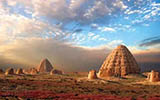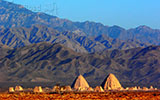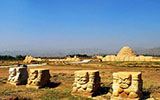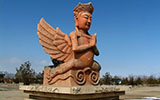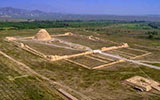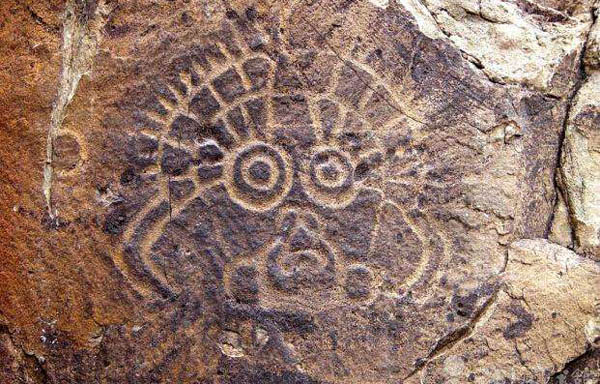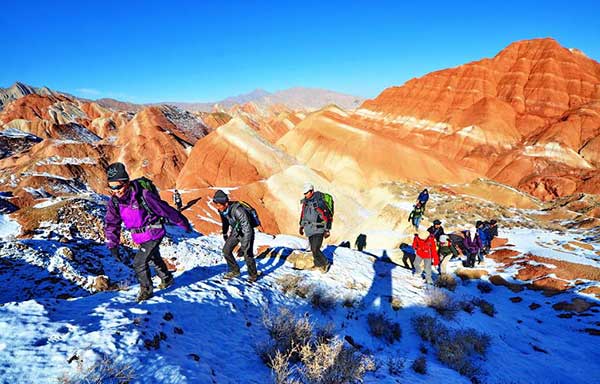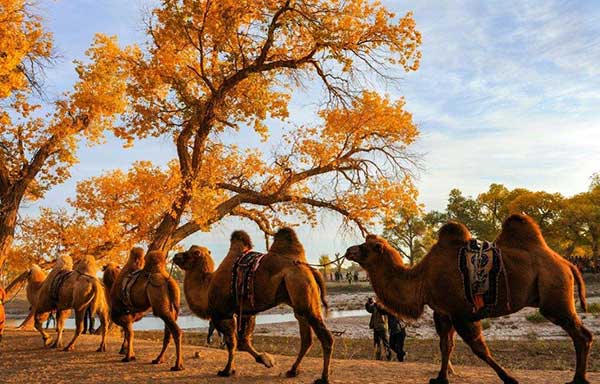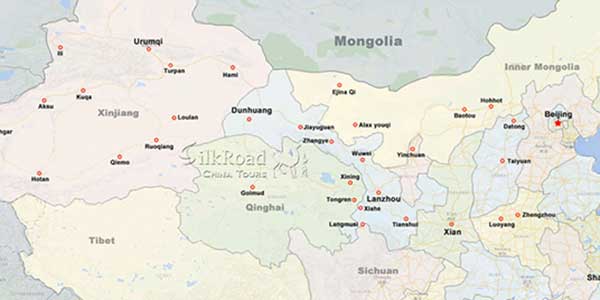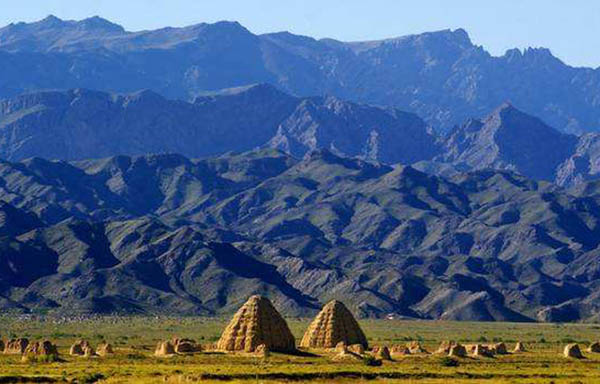 Western Xia mausoleums or Western Xia Imperial Tombs located to the west of Yinchuan city of Ningxia Hui Autonomous Region, at the eastern slope of the Helan Mountains, facing the Yinchuan plateau, with elevation between 1130 to 1200 meters above sea level. They are the royal mausoleums of the emperors in the Western Xia Dynasty (1038-1227), are the best-preserved historic cultural heritage representing the Tangut civilization at the largest scale and in the highest rank.
Western Xia mausoleums or Western Xia Imperial Tombs located to the west of Yinchuan city of Ningxia Hui Autonomous Region, at the eastern slope of the Helan Mountains, facing the Yinchuan plateau, with elevation between 1130 to 1200 meters above sea level. They are the royal mausoleums of the emperors in the Western Xia Dynasty (1038-1227), are the best-preserved historic cultural heritage representing the Tangut civilization at the largest scale and in the highest rank.
Built between the 11th and 13th centuries, these tombs were influenced by Buddhist constructions and integrated the Chinese ,Buddhism and Tangut civilizations. It occupies an area of some 50 square kilometers, the Western Xia Imperial Tombs include 9 imperial mausoleums, 254 subordinate tombs, 1 site of large architectural complex and more than 10 brick-and-tile kiln sites. The imperial mausoleums are lined up along the eastern slope of the Helan Mountains from north to south. The whole grand burial complex extends like a long and narrow south-north ribbon.
Like other imperial tombs, Western Xia mausoleums were composed of two architectural units, the mausoleum gardens above ground and underground palaces. All the mausoleum gardens faced south, and their architectural forms above ground have some unique characteristics, though they are quite similar to mausoleums of the Tang and Northern Song dynasties in Gongxian County.
Based on some excavations, each mausoleum had a unified layout, occupying an area of more than 100,000 square meters, surrounded by inner and outer walls. At each corner of the mausoleum gardens were watchtowers, providing visual indicators of the boundaries, serving functions similar to those of watchtowers of the Imperial Palace (Forbidden City) in Beijing. Mausoleum gardens were organized from south to north: Stone gates, tablet pavilion, outer city, inner city, hall furnished as an imperial bedroom and spiritual terrace.
In each of the four inner city walls was a gate; between the hall and terrace was an earth ridge shaped like a fish back, about 50 meters long. It was the earth covering of the tomb passage. The northern tip of the ridge was the highest point of the mausoleum garden, and was the mound above the underground palace. The mound, also known as the spiritual terrace, can be seen from some distance because of its height.
The unique characteristics of Western Xia mausoleums are clearly visible on the spiritual terraces. The mausoleum mounds of the Han, Tang and Northern Song dynasties are generally high, square-based packed earth mounds with tapering tops cut flat and gently sloped sides. Completely different, the mounds of Western Xia mausoleums look like squat Buddhist pagodas, round or octagonal and about 20 meters high. Examples seen today have five or seven stories, each of which is built with flying rafters overlaid with rows of tiles, richly decorated with an interspersing of glazed green tiles. The sides of the spiritual terraces are painted a deep red, the red walls and the green tiles providing a striking contrast, making it easy to imagine how magnificent the spiritual terraces must have been.
According to the single imperial mausoleum and three attendant tombs excavated by the Museum of the Ningxia Hui Autonomous Region in 1972-1975, in front of the underground palace of the imperial mausoleum is a 49-metre-long sloping tomb passage. The under-ground palace is a square tomb chamber, narrow in front and broadening somewhat at the rear, about 23 meters deep and flanked by one chamber on each side. The tomb chamber was formed by digging out the yellow earth and using flat, earthen walls, not brick or stone. Only the front wall is built with adobe and whitewashed, with painted images of warriors. Inside the arched tomb gate, the chamber is floored with square bricks. Because the mausoleum was looted and vandalized centuries ago, identity of its occupant remains unknown.
However, important cultural relics were found in the wreckage, including ornaments on gold belts, gilt saddle parts, gilt amour plates, gilt silverware, bamboo carvings and others.
In front of the tomb chambers of the three attendant tombs are stepped tomb passages. The tomb chambers are also square and earthen. In these tombs were found bronze oxen, stone horses and other sacrificial objects.
Gallery
Attractions in the area
Related Tours
General Information
Alias: Western Xia Mausoleums
Loc: 35 km from Yinchuan
Entrance: 95 RMB
Open Time: 08:00~18:00
Relevant blogs
-
How did the name of Tianshui in Gansu come about?
The name Tianshui is very pleasant to the ear, and it reminds one of that exquisitely beautiful verse, "After getting drunk, one doesn't know if the sky is in
-
The 8th Silk Road Hotel Festival was successfully held i
On December 27th, the "8th Silk Road Hotel Festival" grandly opened at the Yujing International Hotel in Zhangye. This hotel festival gathered industry experts,
-
The Karez Irrigation System in Turpan has been selected
On September 3rd, at the 75th Executive Council Meeting of the International Commission on Irrigation and Drainage held in Sydney, Australia, the 2024 (11th bat
-
What is the connection between "dragons" and "snakes
In traditional Chinese culture, the snake has a dual identity of auspiciousness and danger. Ancient people believed that the snake not only possesses divine cha
-
Endangered Przewalski's Horses Spotted at Dunhuang Yume
<p>In early February, a group of special "visitors"—the Przewalski's horses—appeared at the Dunhuang Yumen Pass scenic area in Gansu Province, a U
-
The Fourth Dunhuang Cultural Tourism Supplier Conference
On the morning of February 18th, the Fourth Dunhuang Cultural Tourism Supplier Conference in Northwest China commenced at the Dunhuang International Convention

